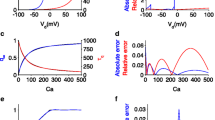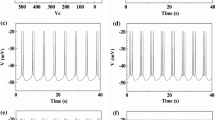Abstract
Based on the minimal neural network models consisting of a pyramidal (PY) neuron, an interneuron (IN), and an astrocyte (AS), we investigate the regulating effects of astrocyte on dynamical transitions in two coupled neurons of the same type of excitability, either Class I or Class II, which is characterized by saddle-node on invariant circle (SNIC) and Hopf (HB) bifurcation, respectively. It is found that without the regulation of AS, the coupled Class I PY and IN neurons show the regular \(L^s\) mixed-mode oscillations (MMOs) composed of L large amplitude oscillations (LAOs) and s small amplitude oscillations (SAOs) in one period. Under the AS action, the calcium signals in AS can induce and regulate the mixed-mode low-frequency bursting firings. By contrast, for the coupled Class II PY and IN neurons, when AS is ignored, as the coupling strength increases, the system shows the periodic LAO oscillations, \(L^s\) mode of oscillations, and the chaotic behaviors. Furthermore, the period-doubling bifurcation is clearly captured. However, the presence of AS makes the PY neuron exhibit the mixed-mode low-frequency chaotic bursting activities. Interestingly, we also discover a new transition route (\(1^0\rightarrow 1^1\rightarrow 1^2\rightarrow \ldots \)) of calcium signals due to the period adding bifurcation of the system, which can shape the firing patterns of the PY neuron. Our results suggest that calcium signals in AS indeed involve in and even shape the coupling dynamics of PY and IN neurons. In particular, AS may exert differential roles in modulating the dynamical properties of Class I and Class II neurons.












Similar content being viewed by others
References
Orkand, R.K., Nicholls, J.G., Kuffler, S.W.: Effect of nerve impulses on the membrane potential of glial cells in the central nervous system of amphibia. J. Neurophysiol. 29(4), 788–806 (1966)
Vernadakis, A.: Glia-neuron intercommunications and synaptic plasicity. Prog. Neurobiol. 49(3), 185–214 (1996)
Kang, J., Jiang, L., Goldman, S.A., Nedergaard, M.: Astrocyte-mediated potentiation of inhibitory synaptic transmission. Nat. Neurosci. 1(8), 683–692 (1998)
Piet, R., Poulain, D.A., Oliet, S.H.: Modulation of synaptic transmission by astrocytes in the rat supraoptic nucleus. J. Physiol. Paris 96(3–4), 231–236 (2002)
Parri, H.R., Gould, T.M., Crunelli, V.: Spontaneous astrocytic \({Ca}^{2+}\) oscillations in situ drive NMDAR-mediated neuronal excitation. Nat. Neurosci. 4(8), 803–812 (2001)
Fellin, T., Pascual, O., Gobbo, S., Pozzan, T., Haydon, P.G., Carmignoto, G.: Neuronal synchrony mediated by astrocytic glutamate through activation of extrasynaptic NMDA receptors. Neuron 43(5), 729–743 (2004)
Koizumi, S., Fujishita, K., Tsuda, M., Shigemoto-Mogami, Y., Inoue, K.: Dynamic inhibition of excitatory synaptic transmission by astrocyte-derived ATP in hippocampal cultures. Proc. Nat. Acad. Sci. 100(19), 11023–11028 (2003)
Zhang, Jm., Wang, Hk., Ye, Cq., Ge, W., Chen, Y., Jiang, Zl., Wu, Cp., Poo, Mm., Duan, S.: ATP released by astrocytes mediates glutamatergic activity-dependent heterosynaptic suppression. Neuron 40(5), 971–982 (2003)
Lee, S., Yoon, B.E., Berglund, K., Oh, S.J., Park, H., Shin, H.S., Augustine, G.J., Lee, C.J.: Channel-mediated tonic GABA release from glia. Science 330(6005), 790–796 (2010)
Henneberger, C., Papouin, T., Oliet, S.H.R., Rusakov, D.A.: Long-term potentiation depends on release of D-serine from astrocytes. Nature 463(7278), 232–236 (2010)
Panatier, A., Theodosis, D.T., Mothet, J.P., Touquet, B., Pollegioni, L., Poulain, D.A., Oliet, S.H.: Glia-derived D-serine controls NMDA receptor activity and synaptic memory. Cell 125(4), 775–784 (2006)
Takata, N., Mishima, T., Hisatsune, C., Nagai, T., Ebisui, E., Mikoshiba, K., Hirase, H.: Astrocyte calcium signaling transforms cholinergic modulation to cortical plasticity in vivo. J. Neurosci. 31(49), 18155–18165 (2011)
Yang, Y., Ge, W., Chen, Y., Zhang, Z., Shen, W., Wu, C., Poo, M., Duan, S.: Contribution of astrocytes to hippocampal long-term potentiation through release of D-serine. Proc. Nat. Acad. Sci. 100(25), 15194–15199 (2003)
Cornell-Bell, A.H., Finkbeiner, S.M., Cooper, M.S., Smith, S.J.: Glutamate induces calcium waves in cultured astrocytes: long-range glial signaling. Science 247(4941), 470–473 (1990)
Charles, A.C., Merrill, J.E., Dirksen, E.R., Sandersont, M.J.: Intercellular signaling in glial cells: calcium waves and oscillations in response to mechanical stimulation and glutamate. Neuron 6(6), 983–992 (1991)
Dani, J.W., Chernjavsky, A., Smith, J.: Neuronal activity triggers calcium waves in hippocampal astrocyte networks. Neuron 8(3), 429–440 (1992)
Pasti, L., Volterra, A., Pozzan, T., Carmignoto, G.: Intracellular calcium oscillations in astrocytes: a highly plastic, bidirectional form of communication between neurons and astrocytes in situ. J. Neurosci. 17(20), 7817–7830 (1997)
Porter, J.T., McCarthy, K.D.: Hippocampal astrocytes in situ respond to glutamate released from synaptic terminals. J. Neurosci. 16(16), 5073–5081 (1996)
Erkan, Y., Saraç, Z., Y\(_l{lmaz}\) E.: Effects of astrocyte onweak signal detection performance of Hodgkin–Huxley neuron. Nonlinear Dyn. 95(4), 3411–3421 (2019)
Araque, A., Parpura, V., Sanzgiri, R.P., Haydon, P.G.: Tripartite synapses: glia, the unacknowledged partner. Trends Neurosci. 22(5), 208–215 (1999)
De Pittà, M., Volman, V., Berry, H., Parpura, V., Volterra, A., Ben-Jacob, E.: Computational quest for understanding the role of astrocyte signaling in synaptic transmission and plasticity. Front. Comput. Neurosci. 6, 98–98 (2012)
Pankratova, E.V., Kalyakulina, A.I., Stasenko, S.V., Gordleeva, S.Y., Lazarevich, I.A., Kazantsev, V.B.: Neuronal synchronization enhanced by neuron-astrocyte interaction. Nonlinear Dyn. 97(1), 647–662 (2019)
Tang, J., Luo, J.M., Ma, J.: Information transmission in a neuron-astrocyte coupled model. PLoS ONE 8(11), e80324 (2013)
Chun, H., Lee, C.J.: Reactive astrocytes in Alzheimer’s disease: a double-edged sword. Neurosci. Res. 126, 44–52 (2018)
Booth, H.D., Hirst, W.D., Wade-Martins, R.: The role of astrocyte dysfunction in Parkinson’s disease pathogenesis. Trends Neurosci. 40(6), 358–370 (2017)
Steinhäuser, C., Grunnet, M., Carmignoto, G.: Crucial role of astrocytes in temporal lobe epilepsy. Neuroscience 323, 157–169 (2016)
Fan, D., Zheng, Y., Yang, Z., Wang, Q.: Improving control effects of absence seizures using single-pulse alternately resetting stimulation (SARS) of corticothalamic circuit. Appl. Math. Mech. 41(9), 1287–1302 (2020)
Valori, C.F., Guidotti, G., Brambilla, L., Rossi, D.: Astrocytes: emerging therapeutic targets in neurological disorders. Trends Mol. Med. 25(9), 750–759 (2019)
Fan, D., Wang, Q.: Synchronization and bursting transition of the coupled Hindmarsh-Rose systems with asymmetrical time-delays. Sci. China Technol. Sci. 60(7), 1019–1031 (2017)
Rakshit, S., Bera, B.K., Ghosh, D.: Synchronization in a temporal multiplex neuronal hypernetwork. Phys. Rev. E 98(3), 032305 (2018)
Amiri, M., Hosseinmardi, N., Bahrami, F., Janahmadi, M.: Astrocyte- neuron interaction as a mechanism responsible for generation of neural synchrony: a study based on modeling and experiments. J. Comput. Neurosci. 34(3), 489–504 (2013)
Makovkin, S.Y., Shkerin, I.V., Gordleeva, S.Y., Ivanchenko, M.V.: Astrocyte-induced intermittent synchronization of neurons in a minimal network. Chaos Solitons Fractals 138, 109951 (2020)
Motter, A.E.: Spontaneous synchrony breaking. Nat. Phys. 6(3), 164–165 (2010)
Bera, B.K., Rakshit, S., Ghosh, D., Kurths, J.: Spike chimera states and firing regularities in neuronal hypernetworks. Chaos 29(5), 053115 (2019)
Bera, B.K., Ghosh, D., Lakshmanan, M.: Chimera states in bursting neurons. Phys. Rev. E 93(1), 012205 (2016)
Majhi, S., Bera, B.K., Ghosh, D., Perc, M.: Chimera states in neuronal networks: a review. Phys. Life Rev. 28, 100–121 (2019)
Wang, Z., Baruni, S., Parastesh, F., Jafari, S., Ghosh, D., Perc, M., Hussain, I.: Chimeras in an adaptive neuronal network with burst-timing-dependent plasticity. Neurocomputing 406, 117–126 (2020)
Liang, S., Wang, Z.: Controlling a neuron by stimulating a coupled neuron. Appl. Math. Mech. 40(1), 13–24 (2019)
Mondal, A., Upadhyay, R.K., Ma, J., Yadav, B.K., Sharma, S.K., Mondal, A.: Bifurcation analysis and diverse firing activities of a modified excitable neuron model. Cogn. Neurodyn. 13(4), 393–407 (2019)
Parastesh, F., Rajagopal, K., Karthikeyan, A., Alsaedi, A., Hayat, T., Pham, V.T.: Complex dynamics of a neuron model with discontinuous magnetic induction and exposed to external radiation. Cogn. Neurodyn. 12(6), 607–614 (2018)
Hodgkin, A.L.: The local electric changes associated with repetitive action in a non-medullated axon. J. Physiol. 107(2), 165–181 (1948)
Izhikevich, E.M.: Dynamical Systems in Neuroscience: The Geometry of Excitability and Bursting. MIT Press, Cambridge (2006)
Prescott, S.A., De Koninck, Y., Sejnowski, T.J.: Biophysical basis for three distinct dynamical mechanisms of action potential initiation. PLoS Comput. Biol. 4(10), e1000198 (2008)
Wang, H., Wang, L., Yu, L., Chen, Y.: Response of Morris–Lecar neurons to various stimuli. Phys. Rev. E 83(2), 021915 (2011)
Nguyen, L.H., Hong, K.S., Park, S.: Bifurcation control of the Morris–Lecar neuron model via a dynamic state-feedback control. Biol. Cybern. 106(10), 587–594 (2012)
Liu, Y., Li, C.: Stochastic resonance in feedforward-loop neuronal network motifs in astrocyte field. J. Theor. Biol. 335, 265–275 (2013)
Li, Y.X., Rinzel, J.: Equations for \(InsP_3\) receptor-mediated \({[Ca^{2+}]}_i\) oscillations derived from a detailed kinetic model: a Hodgkin–Huxley like formalism. J. Theor. Biol. 166(4), 461–473 (1994)
Sneyd, J., Wetton, B.T., Charles, A.C., Sanderson, M.J.: Intercellular calcium waves mediated by diffusion of inositol trisphosphate: a two-dimensional model. Am. J. Physiol. 268(6), C1537–C1545 (1995)
Höfer, T., Venance, L., Giaume, C.: Control and plasticity of intercellular calcium waves in astrocytes: a modeling approach. J. Neurosci. 22(12), 4850–4859 (2002)
Volman, V., Ben-Jacob, E., Levine, H.: The astrocyte as a gatekeeper of synaptic information transfer. Neural Comput. 19(2), 303–326 (2007)
Bowser, D.N., Khakh, B.S.: ATP excites interneurons and astrocytes to increase synaptic inhibition in neuronal networks. J. Neurosci. 24(39), 8606–8620 (2004)
Koizumi, S., Fujishita, K., Tsuda, M., Shigemoto-Mogami, Y., Inoue, K.: Dynamic inhibition of excitatory synaptic transmission by astrocyte-derived ATP in hippocampal cultures. Proc. Nat. Acad. Sci. U.S.A. 100(19), 11023–11028 (2003)
Schell, M., Albahadily, F.N.: Mixed-mode oscillations in an electrochemical system. II. A periodic–chaotic sequence. J. Chem. Phys. 90(2), 822–828 (1989)
Ray, A., Rakshit, S., Basak, G.K., Dana, S.K., Ghosh, D.: Understanding the origin of extreme events in El-Niño southern oscillation. Phys. Rev. E 101(6), 062210 (2020)
Acknowledgements
This work was supported by the National Natural Science Foundation of China (Grants No. 11932003).
Author information
Authors and Affiliations
Corresponding author
Ethics declarations
Conflict of interest
The authors declare that they have no conflict of interest.
Additional information
Publisher's Note
Springer Nature remains neutral with regard to jurisdictional claims in published maps and institutional affiliations.
Rights and permissions
About this article
Cite this article
Zhao, J., Fan, D., Wang, Q. et al. Dynamical transitions of the coupled Class I (II) neurons regulated by an astrocyte. Nonlinear Dyn 103, 913–924 (2021). https://doi.org/10.1007/s11071-020-06122-3
Received:
Accepted:
Published:
Issue Date:
DOI: https://doi.org/10.1007/s11071-020-06122-3




